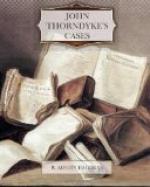“The depth of the footprints shows that he was a much heavier man than either of us,” I suggested; “perhaps he was unusually fat.”
“Yes,” said Thorndyke, “that seems to be the explanation. The carrying of a dead weight shortens the stride, and fat is practically a dead weight. The conclusion is that he was about five feet ten inches high, and excessively fat.” He picked up his cane, and we resumed our walk, keeping an eye on the procession ahead until it had disappeared round a curve in the coast-line, when we mended our pace somewhat. Presently we reached a small headland, and, turning the shoulder of cliff, came full upon the party which had preceded us. The men had halted in a narrow bay, and now stood looking down at a prostrate figure beside which the surgeon was kneeling.
“We were wrong, you see,” observed Thorndyke. “He has not fallen over the cliff, nor has he been washed up by the sea. He is lying above high-water mark, and those footprints that we have been examining appear to be his.”
As we approached, the sergeant turned and held up his hand.
“I’ll ask you not to walk round the body just now, gentlemen,” he said. “There seems to have been foul play here, and I want to be clear about the tracks before anyone crosses them.”
Acknowledging this caution, we advanced to where the constables were standing, and looked down with some curiosity at the dead man. He was a tall, frail-looking man, thin to the point of emaciation, and appeared to be about thirty-five years of age. He lay in an easy posture, with half-closed eyes and a placid expression that contrasted strangely enough with the tragic circumstances of his death.
“It is a clear case of murder,” said Dr. Burrows, dusting the sand from his knees as he stood up. “There is a deep knife-wound above the heart, which must have caused death almost instantaneously.”
“How long should you say he has been dead, Doctor?” asked the sergeant.
“Twelve hours at least,” was the reply. “He is quite cold and stiff.”
[Illustration: Plan of st. Bridget’s bay.
+ Position of body. D D D, Tracks of Hearn’s shoes. A, Top of Shepherd’s Path. E, Tracks of the nailed shoes. B, Overhanging cliff. F, Shepherd’s Path ascending shelving cliff. C, Footpath along edge of cliff.]
“Twelve hours, eh?” repeated the officer. “That would bring it to about six o’clock this morning.”
“I won’t commit myself to a definite time,” said Dr. Burrows hastily. “I only say not less than twelve hours. It might have been considerably more.”
“Ah!” said the sergeant. “Well, he made a pretty good fight for his life, to all appearances.” He nodded at the sand, which for some feet around the body bore the deeply indented marks of feet, as though a furious struggle had taken place. “It’s a mighty queer affair,” pursued the sergeant, addressing Dr. Burrows. “There seems to have been only one man in it—there is only one set of footprints besides those of the deceased—and we’ve got to find out who he is; and I reckon there won’t be much trouble about that, seeing the kind of trade-marks he has left behind him.”




